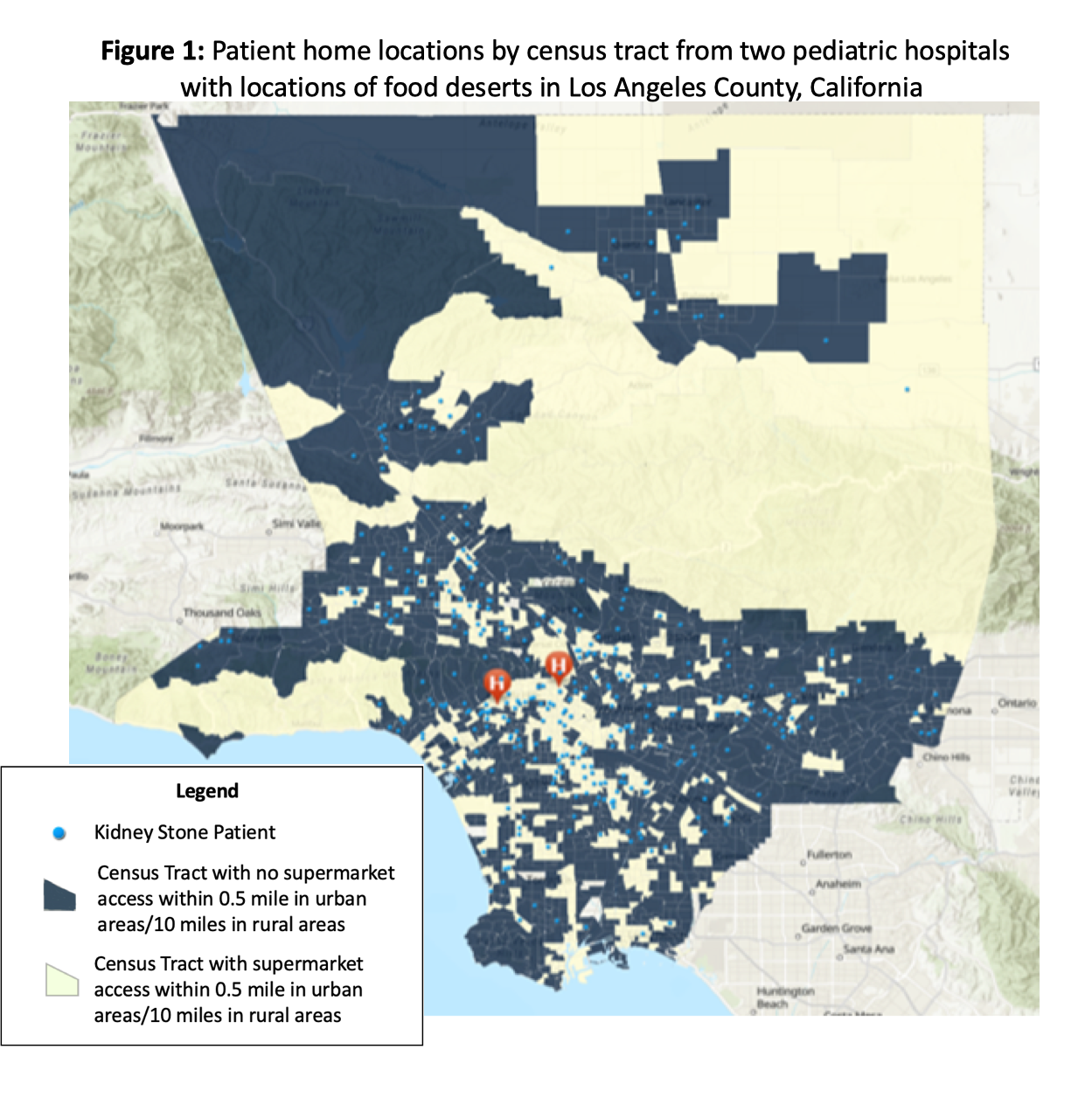Back
Poster, Podium & Video Sessions
Moderated Poster
MP17: Pediatric Urology: Upper & Lower Urinary Tract
MP17-12: Proximity to Food Deserts Increases Risk of Pediatric Nephrolithiasis
Friday, May 13, 2022
4:30 PM – 5:45 PM
Location: Room 225
Arthi Hannallah*, Aurash Naser-Tavakolian, Zoë Baker, Shirley Saker, Thalia Bajakian, Nadine Khouzam, Andrew Freedman, S. Scott Sparks, Los Angeles, CA
- AH
Poster Presenter(s)
Introduction: This study sought to identify a relationship between proximity to food deserts and the prevalence of pediatric nephrolithiasis in Southern California.
Methods: This was a multi-site review of patients with nephrolithiasis from two pediatric hospitals in a dense urban region from 2006 to 2021. Demographics and stone histories were reviewed. Patients’ home addresses were correlated with census tract data and compared to locations of food deserts per the United States Department of Agriculture. Food deserts are regions with no supermarket access within a half-mile radius in urban areas or a 10-mile radius in rural areas. Median household income (MHI) was assessed with the 2019 American Community Survey 5-Year Estimates. Poverty was defined by the California Poverty Measure (CPM), with near poverty as 1-1.5x CPM. Logistic and linear regression models were utilized to analyze the associations between sociodemographic factors and stone-related outcomes.
Results: We identified 429 pediatric patients in Southern California seen for nephrolithiasis. Table 1 includes demographic data, poverty rate, and access to supermarkets. Compared to those who did not live in food deserts, patients living in food deserts experienced their first stone episode 1.13 years earlier (95% CI: 0.08-2.19 years earlier; p=0.04) and were 1.53 times more likely to require surgery for stones with a trend toward statistical significance (95% CI: 0.96-2.43; p=0.07, Figure 1). Patients living in low-income neighborhoods were 1.86 times more likely to be overweight or obese than patients with stones living in higher-income neighborhoods (95% CI: 1.10-3.15; p=0.02).
Conclusions: Proximity to food deserts is associated with an increased risk of pediatric nephrolithiasis at a younger age and potentially requiring more surgical stone interventions. Obesity is more prevalent among patients residing in low-income neighborhoods. Dietary efforts that assess the access and ability to provide adequate nutrition should be evaluated in pediatric patients with nephrolithiasis.
Source of Funding: none


Methods: This was a multi-site review of patients with nephrolithiasis from two pediatric hospitals in a dense urban region from 2006 to 2021. Demographics and stone histories were reviewed. Patients’ home addresses were correlated with census tract data and compared to locations of food deserts per the United States Department of Agriculture. Food deserts are regions with no supermarket access within a half-mile radius in urban areas or a 10-mile radius in rural areas. Median household income (MHI) was assessed with the 2019 American Community Survey 5-Year Estimates. Poverty was defined by the California Poverty Measure (CPM), with near poverty as 1-1.5x CPM. Logistic and linear regression models were utilized to analyze the associations between sociodemographic factors and stone-related outcomes.
Results: We identified 429 pediatric patients in Southern California seen for nephrolithiasis. Table 1 includes demographic data, poverty rate, and access to supermarkets. Compared to those who did not live in food deserts, patients living in food deserts experienced their first stone episode 1.13 years earlier (95% CI: 0.08-2.19 years earlier; p=0.04) and were 1.53 times more likely to require surgery for stones with a trend toward statistical significance (95% CI: 0.96-2.43; p=0.07, Figure 1). Patients living in low-income neighborhoods were 1.86 times more likely to be overweight or obese than patients with stones living in higher-income neighborhoods (95% CI: 1.10-3.15; p=0.02).
Conclusions: Proximity to food deserts is associated with an increased risk of pediatric nephrolithiasis at a younger age and potentially requiring more surgical stone interventions. Obesity is more prevalent among patients residing in low-income neighborhoods. Dietary efforts that assess the access and ability to provide adequate nutrition should be evaluated in pediatric patients with nephrolithiasis.
Source of Funding: none



.jpg)
.jpg)